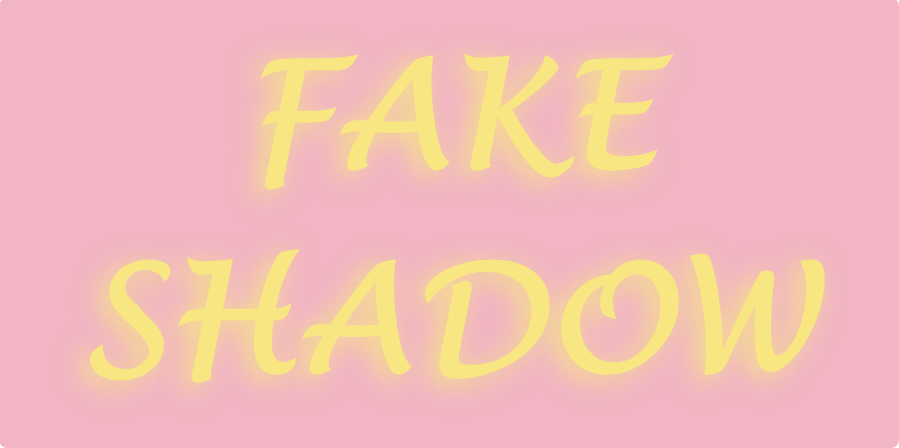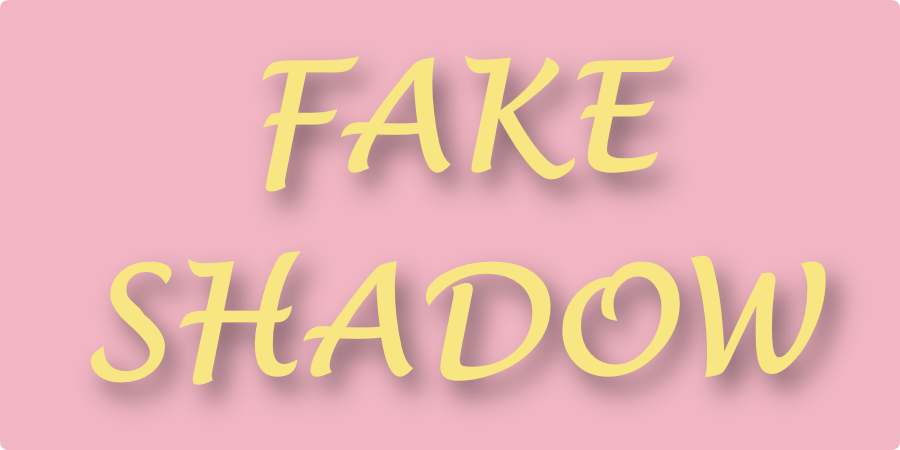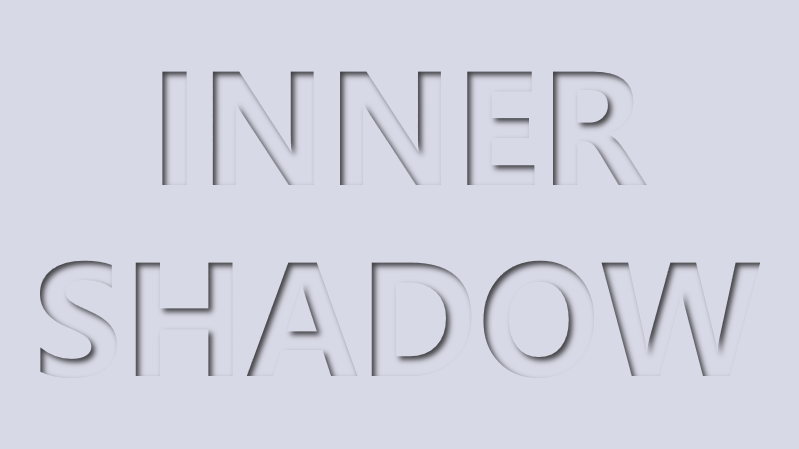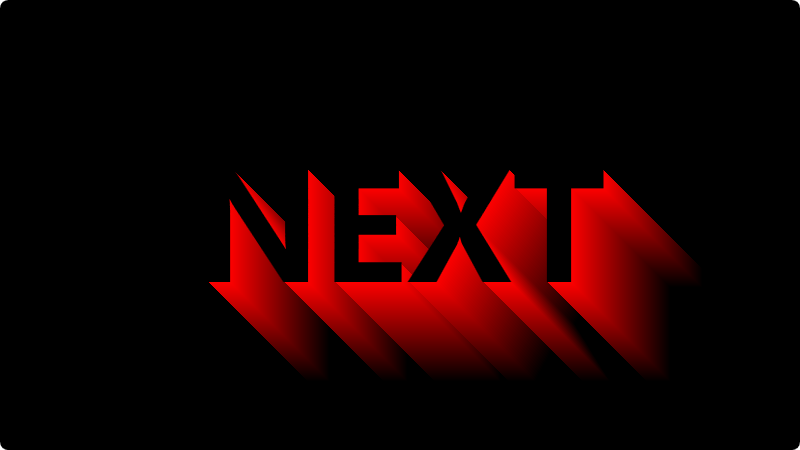最近在学习怎么用 Shazzam Shader Editor 编写自定义的 Effect,并试着去实现阴影、内阴影和长阴影的效果。结果我第一步就放弃了,因为阴影用到的高斯模糊算法对我来说太太太太太太太太难了,最后只好用些投机取巧的方法来模仿这几种效果。
1. 阴影WPF 中的 DropShadowEffect 简单来说就是将输入源的图像进行高斯模糊,然后根据 Color、Opacity、Direction、ShadowDepth 这几个属性来修改颜色、透明度和位移,形成一张新的图像作为阴影,平铺在原图像的背后。要自己实现 DropShadowEffect 最大的难点就在高斯模糊这里,既然写不出高斯模糊算法,就只好依赖 WPF 现有的东西。我的做法是用一个 VisualBrush 获取需要做阴影的图像,然后再用 WPF 的 BlurEffect 让它变模糊:
<Grid ClipToBounds="True">
<Grid>
<Grid.Effect>
<BlurEffect Radius="38" />
</Grid.Effect>
<Grid.Background>
<VisualBrush Stretch="None" Visual="{Binding ElementName=ForegroundElement}" />
</Grid.Background>
</Grid>
</Grid>
<Grid x:Name="ForegroundElement">
<TextBlock VerticalAlignment="Center"
FontFamily="Lucida Handwriting"
FontSize="148"
FontWeight="ExtraBold"
Foreground="#f7e681"
TextAlignment="Center">
FAKE<LineBreak />
SHADOW</TextBlock>
</Grid>
现在的它看起来就是这个样子。

然后写一个 FakeDropShadowEffect。它获取输入源的 Alpha 通道,将 RGB 替换为指定的颜色(默认是黑色),组合成新的颜色。再通过 Angle 和 Depth 计算出偏移:
float4 main(float2 uv : TEXCOORD) : COLOR
{
float4 c = 0;
float rad = Angle * 0.0174533f;
float xOffset = cos(rad) * Depth;
float yOffset = sin(rad) * Depth;
uv.x += xOffset;
uv.y += yOffset;
c = tex2D(Texture1Sampler, uv);
c.rgb = Color.rgb * c.a * Opacity;
c.a = c.a * Opacity;
return c;
}
最后在应用了 BlurEffect 的元素外面再套一层 Grid,然后在这个 Grid 应用刚刚写的 FakeDrpShadowEffect:
<Grid ClipToBounds="True">
<Grid.Effect>
<effects:FakeDropShadowEffect Angle="225"
Depth="0.03"
Opacity="0.5" />
</Grid.Effect>

成果如上图所示,和 DropShadowEffect 几乎一样了。
2. 内阴影关于内阴影的实现,我之前写过另一篇文章介绍过:实现 WPF 的 Inner Shadow。现在用 Effect,我首先想到的做法是叠加两个元素,上层的元素根据另一个元素的 VisualBrush 剪切出一个洞,然后在这个洞投下阴影:
<Grid x:Name="BackgroundElement">
<TextBlock x:Name="Text"
HorizontalAlignment="Center"
VerticalAlignment="Center"
FontSize="150"
FontWeight="Bold"
Foreground="{StaticResource LightBackground}"
TextAlignment="Center">
INNER<LineBreak />
SHADOW</TextBlock>
</Grid>
<Grid ClipToBounds="True">
<Grid.Effect>
<DropShadowEffect BlurRadius="8"
Opacity="0.7"
ShadowDepth="5" />
</Grid.Effect>
<Grid Background="{StaticResource LightBackground}">
<Grid.Effect>
<effects:ClipEffect>
<effects:ClipEffect.Blend>
<VisualBrush Stretch="None" Visual="{Binding ElementName=BackgroundElement}" />
</effects:ClipEffect.Blend>
</effects:ClipEffect>
</Grid.Effect>
</Grid>
</Grid>
在上面的 XAML 中,ClipEffect 有另一个输入 Blend,这个输入就是要剪切的形状。ClipEffect 的代码很简单,就只是几行,关键的功能是用 input 的Alpha 通道减去 blend 的 Alpha 通道作为结果输出:
sampler2D blend : register(s1);
float4 main(float2 uv : TEXCOORD) : COLOR
{
float4 inputColor = tex2D(input, uv);
float4 blendColor = tex2D(blend, uv);
float4 resultColor = 0;
float opacity = inputColor.a - blendColor.a;
resultColor.rgb = inputColor.rgb * opacity;
resultColor.a = opacity;
return resultColor;
}
下图是上面的 XAML 实现的效果:

我以前写过一篇在 UWP 实现长阴影的博客:使用GetAlphaMask和ContainerVisual制作长阴影(Long Shadow) 。这次在 WPF 里重新用 Effect 实现一次。长阴影的原理是不断向左上角(因为偷懒就只是做向右下的阴影)检查,直到遇到 Alpha 通道为 1 的像素,然后计算这个像素与自身的距离得出阴影的 Alpha,所有代码如下:
float4 main(float2 uv : TEXCOORD) : COLOR
{
float4 srcColor = tex2D(input, uv);
if (srcColor.a == 1)
{
return srcColor;
}
float4 tempColor = 0;
float2 offset = 0;
int maxDepth = 400;
float a = 0;
for (float i = 1; i < maxDepth; i++)
{
if (i < ShadowLength)
{
if (a == 0)
{
offset = uv.xy - float2(i / Width, i / Height);
if (offset.x > 0 && offset.y > 0)
{
tempColor = tex2D(input, offset);
if (tempColor.a == 1)
{
a = (1 - i / max(1,ShadowLength));
}
}
}
}
}
if (a == 0)
{
return srcColor;
}
a = min(1,a);
tempColor.rgb = Color.rgb * a * Opacity;
tempColor.a = a * Opacity;
float4 outColor = (1 - srcColor.a) * tempColor + srcColor;
return outColor;
}
使用起来的 XAML 和效果如下,需要输入 ShadowLength 和 Color,因为 Effect 没法知道输入源的尺寸,所以还需要主动输入 Width 和 Height:
<Grid x:Name="Root" Background="Transparent">
<Grid.Effect>
<effects:LongShadowEffect Width="{Binding ElementName=Root, Path=ActualWidth}"
Height="{Binding ElementName=Root, Path=ActualHeight}
ShadowLength="100"
Color="Red" />
</Grid.Effect>
<TextBlock x:Name="TextBlock"
HorizontalAlignment="Center"
VerticalAlignment="Center"
FontSize="150"
FontWeight="Bold"
Text="NEXT" />
</Grid>

https://github.com/DinoChan/wpf_design_and_animation_lab
